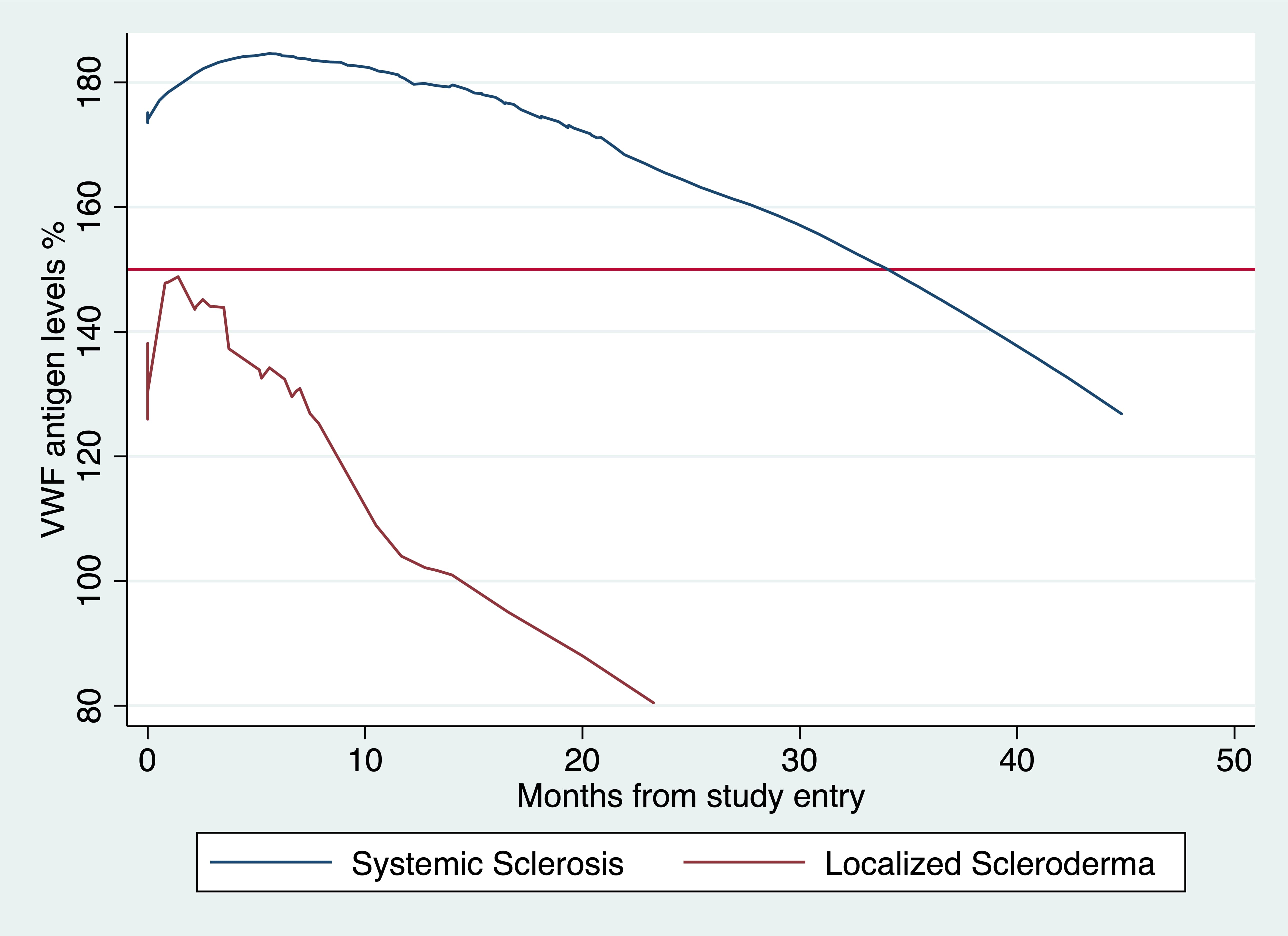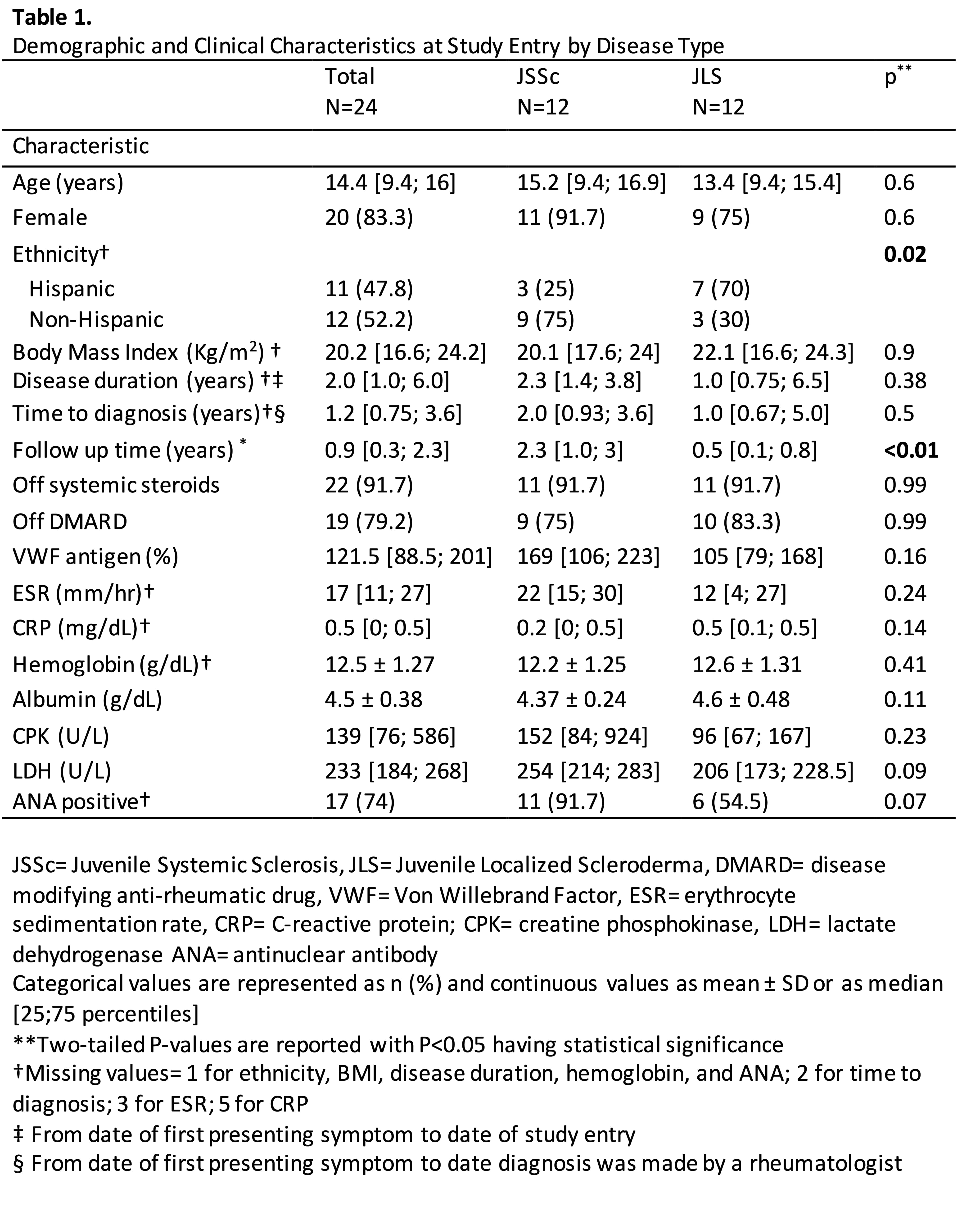Session Information
Date: Sunday, November 8, 2020
Title: Pediatric Rheumatology – Clinical Poster II: Systemic JIA, Autoinflammatory, & Scleroderma
Session Type: Poster Session C
Session Time: 9:00AM-11:00AM
Background/Purpose: Juvenile Scleroderma (JScl) is a heterogenous disease characterized by autoimmunity, vasculopathy, and fibrosis. Morbidity and mortality remain high in part due to the continuing limited understanding of disease pathogenesis, and in part due to the lack of validated biomarkers. Von Willebrand Factor (VWF) is a multimeric glycoprotein synthesized in endothelial cells (ECs) with high prothrombotic properties. In Scl, VWF has emerged as a potential biomarker based on evidence indicating that EC injury might be central to the pathogenesis. Cross-sectional studies in adults with Scl indicate: 1) levels of VWF antigen (Ag) in plasma are found elevated compared to healthy controls, 2) baseline levels can predict death and future development of pulmonary hypertension, and 3) presence of high-molecular weight multimers (HMWM), being the most active forms of VWF, may contribute to the significant microangiopathy. Longitudinal studies exploring the role of VWF as a disease biomarker in Scl are lacking and there is limited understanding of its use in patients with childhood-onset disease. We aim to describe trajectories of VWF Ag levels over time in patients with JScl and its association with disease type. We also investigate for predictors of persistently elevated levels of VWF Ag, and for the presence of HMWM
Methods: Data of children ages < 18 years, fulfilling the 2007 Pediatric Rheumatology Provisional Classification Criteria for Juvenile Systemic Sclerosis (JSSc) and the Padua Criteria for Juvenile Localized Scleroderma (JLS) were reviewed between 2009-2020. Trends in VWF Ag levels were explored using time series plot. Cross-sectional and longitudinal analysis using linear and logistic regression models with GEE were performed to look for: 1) association of VWF Ag levels with disease type, and 2) independent predictors of persistently elevated levels of VWF Ag defined as a value of >150% in ≥75% of the visits. Leftover samples kept frozen for quality control studies were extracted for VWF multimeric analysis to study the presence of HMWM, and for the Ristocetin Cofactor assay to assess VWF activity [expressed as VWF Activity (Act): VWF Ag ratio]
Results: Twenty-four patients with JScl (50% jSSc, 50% JLS) were studied (Table 1). A negative trend in VWF Ag levels with different patterns in JSSc vs. JLS patients was seen (Figure 1). No statistically significant association was found between VWF Ag levels and disease type. Disease severity was an independent predictor of VWF Ag levels when adjusting for disease type (52.6% ± 23.7%, p=0.03). Skin ulcers (OR 0.25, p=0.01), exposure to DMARDs (OR 0.27, p=0.008), and Non-Hispanic ethnicity (OR 4.0, p=0.04) are independent predictors of persistently elevated levels of VWF Ag. In 8/15 samples (53%), HMWM of VWF were found elevated while median VWF Act: VWF Ag ratio was decreased [0.44 (IQR 0.21; 0.55)]
Conclusion: Consistent with literature in adults, in patients with childhood-onset disease: 1) elevated levels of VWF Ag are found in plasma, 2) higher levels of VWF Ag predict disease severity, and 3) a high proportion of individuals have circulating levels of HMWM of VWF. Larger prospective studies are needed to further characterize VWF and its potential use as a disease biomarker in JScl
 Figure 1. Lowess smoothed time series plot of Von Willebrand Factor antigen levels versus time by disease type. The normal upper cutoff value of VWF is represented by the horizontal red line (=150%). There is a negative trend of VWF antigen levels over time in both groups. Patients with systemic sclerosis have higher and more chronically elevated levels of VWF antigen compared to those with localized scleroderma. VWF=Von Willebrand Factor.
Figure 1. Lowess smoothed time series plot of Von Willebrand Factor antigen levels versus time by disease type. The normal upper cutoff value of VWF is represented by the horizontal red line (=150%). There is a negative trend of VWF antigen levels over time in both groups. Patients with systemic sclerosis have higher and more chronically elevated levels of VWF antigen compared to those with localized scleroderma. VWF=Von Willebrand Factor.
To cite this abstract in AMA style:
Vasquez-Canizares N, Agarwal B, Rubinstein T, Wahezi D, Reyes-Gil M. Exploring the Use of Von Willebrand Factor as a Disease Biomarker in a Cohort of Patients with Juvenile Scleroderma: A Pilot Study [abstract]. Arthritis Rheumatol. 2020; 72 (suppl 10). https://acrabstracts.org/abstract/exploring-the-use-of-von-willebrand-factor-as-a-disease-biomarker-in-a-cohort-of-patients-with-juvenile-scleroderma-a-pilot-study/. Accessed .« Back to ACR Convergence 2020
ACR Meeting Abstracts - https://acrabstracts.org/abstract/exploring-the-use-of-von-willebrand-factor-as-a-disease-biomarker-in-a-cohort-of-patients-with-juvenile-scleroderma-a-pilot-study/

